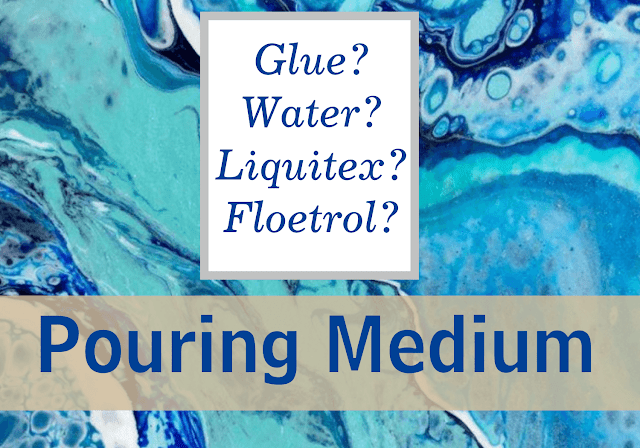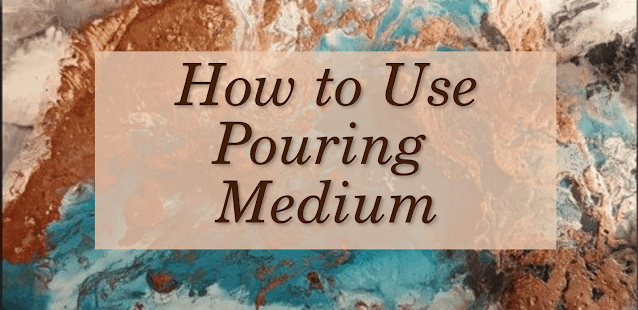This art form is commonly know as Acrylic Pouring or Fluid Acrylic Painting, both. Since the paint is literally poured on to the canvas instead of using brushes, name is rightly given so.
There is always something more to learn hence this guide is helpful for artist at all level. Lets address the most common which comes to mind when you think of Acrylic Pouring.
What's a pouring medium?
A pouring medium is an additive used to make acrylic paints pour and flow smoothly and freely. Pouring medium acts like a diluting agent and binder.
Pouring Mediums are important because:
- The vibrancy, color, opacity and texture
of the colors are intact
- They give acrylic paint smoother and uniform circulation of colors
- They also improve the overall integrity of the paints,they dry and finish without cracking, dividing, or evaporating.
- They make acrylics simpler to work together and much more acceptable
Can we use water as pouring medium?
Using water to thin your acrylics is a simple, easy and inexpensive way to make paint much easier to use when you are pouring. When you're attempting to stick onto a budget, water is a fantastic medium to start out with.
However, using water will have significant cons.
- Water will dilute your colors, meaning, the vibrancy of your paint is going to be dropped when on the canvas.
- Water also dilutes the binding agents on your paints, which means they won't stick to canvas and won't work well with all surfaces.
- Water can't completely bind with paint, so it results in an irregular consistency when you start working with your thinned acrylics.
- With water, you may discover that your paints lift of the canvas when they're dry. Layers won't adhere to each other either.
- Water affects the pigments, binders, and finish when dry. Overall, your paintings probably will not have the exact same vibrancy or quality they ought to.
Types of Pouring Mediums
There's quite a range of pouring mediums available in the market. Important difference between them is there consistency, gloss level, flow ability and drying time.
Consistency is chosen based on the paint used. For thinner acrylic paint, thicker pouring medium should be preferred. While for thicker or heavy body paint, thinner consistency pouring medium is suggested to be used.
Gloss level is added as an additive to increase the gloss level. Regardless of the acrylic paint used, this medium gives a uniform degree of gloss. In addition, the colors are shown to their best advantage with such a casting medium.
Flow ability of some pouring mediums are excellent i.e. they can be easily and evenly distributed in the paint. While some pouring mediums, mixing is extremely difficult. Sometime undesired results occur as flow ability is present but far from optimal.
Drying time differs for each pouring medium. In the marketplace, there are mediums available which dry completely over night, while some other products take few days.
Most pouring mediums fall under the 'all-purpose' class. Generally, they'll maximize the consistency, binding and flow of your own paints.
Floetrol and Liquitex are a great illustration of popular pouring mediums that are considered 'all-purpose'.
Today, there are many options available that are intended for a specific function. These are mostly additives for adding strength to archival pieces or even more visually oriented goods such as a gloss medium.
Can we make pouring medium at home?
Yes. Most homemade pouring medium recipes use a combination of glue and water, often combined with some other substances, to make a substance that can be used to thin out paint so it is pour-able.
1. Glue and Water
Mix equal parts water and white glue in a jar and shake to mix. Add this pouring medium to the paint. You can mix it in other cups if your bottles are full.
You can dilute to craft paint with the medium up to 50% without affecting the binding of the paint to the canvas.
2. Glue and Floterol
Floterol is a substance used by professional painters that changes the thickness of paint without changing the color.
It makes it easier to use acrylic paint in a paint sprayer, or when you use a roller it’s supposed to eliminate the roller marks. Floetrol is totally inert when dry and has excellent longevity.
This works well for beginners and intermediate artists, with many artist using it as a standalone all-purpose pouring medium.
Before using mixture of glue and floetrol for pouring, always strain through a mesh paint strainer.
It’s completely normal for lumps to form as these products settle and does not mean that the product has spoiled. Straining will help you to avoid any unwanted lumps.
Mix Floetrol and Glue-All at a ratio of 1 part Glue-All to 4 parts Floetrol. Combine the two products and stir thoroughly. Make sure that they are well incorporated to avoid unwanted separation.
Different ratios of glue and floetrol (1:2, 1:3,1:4) are also commonly used. You can try your own ratio and judge what suits you.
Additionally, you can use Floetrol as an additive along with one of the other all-purpose mediums, since it can promote the cell creation.
3. PVA Glue
This is a common glue that can be found in most art classrooms. It’s used and favored by many popular pouring artists, although opinions on it’s quality are varied.
PVA Glue (also known as Elmer’s Glue All in the US) can be used to make a very inexpensive DIY pouring medium. This does all the basics fairly well, and has all the binding ability you’d expect from an adhesive.
Steps To Use Pouring Mediums
The most traditional method for using a pouring medium to create acrylic pour art is flip the cup. Lets look at this method in detail below.
1. Add your paint to a plastic cup, one for each of them. Add a small amount of paint to the cup, typically just enough to cover the bottom.
The amounts of medium you should add to this paint will depend on a number of things, including the size of your canvas or board, as well as how many colors you are using.
A typical rule of thumb for medium body acrylics is 1 part paint to 3 parts pouring medium, meaning you’re using more pouring medium than you are actual acrylic paint.
2. Add the pouring medium to all of your different colors and mix them well using a stirrer or popsicle stick. The next step is to combine your colors.
Using another, clean cup, begin adding your various colors and layering them on top of one another in the cup. You can repeat colors and use more of the colors you wish to be more prominent in your painting.
3. Now comes the fun part! This is the step where you apply paint to your canvas or board to create an amazing masterpiece.
Begin by placing your canvas, face down, on top of your cup. Place your hand on the back of the canvas for support and hold onto the cup, flipping them quickly so that your cup is resting upside down on the canvas.
Wait a few moments for the paint to flow towards the canvas.
4. Next, you can either spread the cup across the canvas to begin moving the paint, or lift the cup directly up, allowing the paint to spread and flow across the surface.
Tilt the canvas to allow the paint to flow fully across the canvas, covering the edges and corners.
You can blow through a straw to move the paint around and lift up the various colors you want to expose and create all kinds of different looks.
5. While you wait, you can apply a base color to the rest of the canvas. This will typically either be black or white paint already mixed with the pouring medium.
Pour it across the canvas and spread it around the
edges of your cup and across the canvas with a palette knife.
There are many different ways to experiment with acrylic pouring to create wonderful art.
Quantity of Pouring Medium To Use
The amount of pouring medium you need will depend on three factors mainly:
How thick or thin your paint is?
How big your project is?
What Pouring technique you are going to use?
For thicker paints like Liquitex you might need a bit more medium to get the right consistency.
For thinner paints like Liquitex Basics, ratio is likely 1 part Liquitex to 3 parts medium. This may vary based on your desired consistency
Which Medium is good to start with?
It is a great idea to experiment with a variety of different mediums. You'll want to use paints from different brands to find your favorite colors, and you'll want to play with a range of pouring mediums for the exact same reason!
Try with one of two mediums to begin with. For example, many artist use an all-purpose medium (like Liquitex or Floetrol) and rather then a more special additive gloss to give a shiny finish or a few silicone oil to get better cells.After some experiments, you will discover what works well for you and what does not work for you. Then you can decide which is your preferred product and you can continue using that.
It is
certainly not possible to remember what all steps you have taken in each
pour. Hence you should take notes when doing each process so you can look and refer them. Check Acrylic Pouring Guide for Beginners.
Advantages of using Pouring Mediums
There are a number of advantages to working with those additives.
- Color vibrancy and integrity is retained
- The flow dynamics of the paint mixture is excellent
- Pouring mediums actually bind to the paints, unlike water, thus stop cracking/crazing
- If you use a pouring medium, you won't require water to make your paints flow the way you desire.
- A pouring medium may also extend the drying time of the paint, which makes it easier to work on your painting for a longer period or to create faux finishes.
Wrapping Up
I hope some basic questions are answered about pouring mediums! This is a big subject for many beginners. Do not forget to read Acrylic Pouring Tips, they'll make your pours much easier to work with and your results will be far better.

